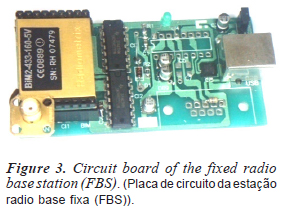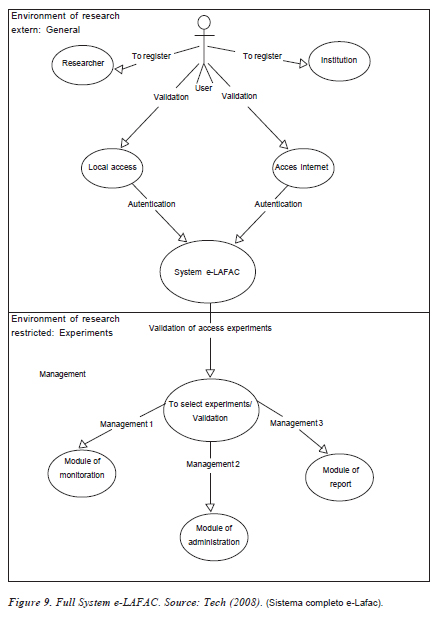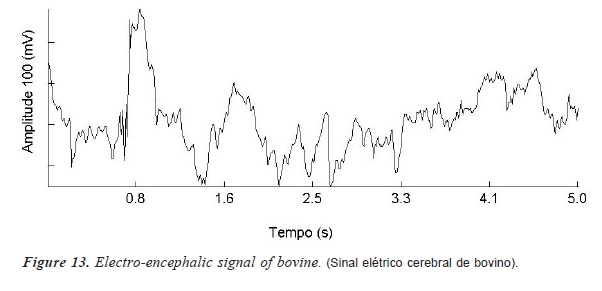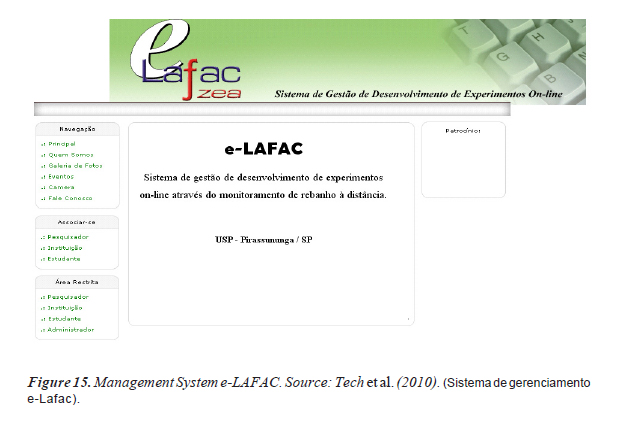Mi SciELO
Servicios Personalizados
Revista
Articulo
Indicadores
-
 Citado por SciELO
Citado por SciELO -
 Accesos
Accesos
Links relacionados
-
 Citado por Google
Citado por Google -
 Similares en
SciELO
Similares en
SciELO -
 Similares en Google
Similares en Google
Compartir
Archivos de Zootecnia
versión On-line ISSN 1885-4494versión impresa ISSN 0004-0592
Arch. zootec. vol.61 no.234 Córdoba jun. 2012
https://dx.doi.org/10.4321/S0004-05922012000200002
A wireless data acquisition system for cattle behavior monitoring in zootechnics E-Science
Aquisição de dados sem fio para monitoramento do comportamento do gado em um E-Science zootécnico
Tech, A.R.B.1*, Arce, A.I.C.1A, Silva, A.C.S.1B and Costa, E.J.X.1C
1ZAB-FZEA. University of São Paulo. Pirassununga, SP. Brazil.
*adriano.tech@usp.br; Aacaid@usp.br; Banac_ss@yahoo.com.br; Cernane@usp.br
SUMMARY
This paper studies the feasibility of a system of monitoring and data collection via the web, with the construction of an e-Science Zootechnical. Object-oriented modelling techniques were used and programming languages: php, C++, Java and MySql database for development of the computing environment. The system hardware, electronic communication device, and monitoring protocols were developed using the Float Base Sensor Network Protocol and techniques of electronic instrumentation. To test the system, an experiment was conducted with six Holstein animals equipped with data collection devices. The experimental environment was equipped with six antennas and a fixed IP camera. The results showed the efficiency of the collection system and receiving data through the antennas distributed in the area. Considering the methodology used in the project, as well as the results of the experiment, is possible conclude that, with the telemetric data collection in real time, the management and monitoring the animal during an experiment can be done, in addition to allowing free movement of the animal during the data collection.
Key words: Interface. Identification system. Data warehouse.
RESUMO
Este artigo estuda a viabilidade de um sistema de monitoramento e coleta de dados através da WEB, com a construção de um e-Science Zootécnico. Foram utilizadas técnicas de modelagem orientada a objetos, linguagens de programação php, C++, Java e banco de dados MySql para a elaboração do ambiente computacional. O sistema de hardware, o dispositivo eletrônico de comunicação e os protocolos de monitoramento foram desenvolvidos utilizando o protocolo Float Base Sensor Network e técnicas de instrumentação eletrônica. Para testar o sistema desenvolvido, foi realizado um experimento com 6 animais da raça Holstein equipados com dispositivos de coleta de dados. O ambiente experimental foi equipado com 6 antenas fixas e uma câmera IP. Os resultados obtidos mostraram a eficiência do sistema de coleta e de recepção dos dados através das antenas distribuídas na área. A metodologia usada no projeto, bem como os resultados do experimento, permitem concluir que o objetivo de gerenciar e monitorar o animal durante um experimento, com a coleta de dados telemétricos em tempo real foi alcançada, além de possibilitar o deslocamento livre do animal durante a coleta dos dados.
Palavras chave: Interface. Sistema de identificação. Data warehouse.
Introduction
There are several factors that interfere with the animal productivity, such as genetics, nutrition, bioclimatology and environmental factors. Thus, farmers and scientists need to acquire data that will enable to understand how animals respond these factors in order to provide strategic decisions in the management and improvement of production (Arce et al., 2009).
In this conception several people study the way to collect data from animals in displacement. Technology based in electronic instrumentation has contributed to analyze data provided by animals.
Electronic radio frequency identification (RFID) of animals presents many advantages within the agribusiness administration, especially in behavioral studies, and is a considerable improvement over visual identification. The greatest benefits of using this technique in animal tracking include a reduction of operational cost, since less herd handling is necessary, and a decrease of incorrect data readings from a margin of 6% to less than 0.1% (Eradus and Jansen, 1999; Geers et al., 1997).
Considering these advantages, it is possible to identify the necessity of software that will allow scientists and producers to manage herd behavior and routines through systems and information-based technologies, such as wireless communication; intelligent agents embedded in software; and electronic identification for monitoring, tracking, and controlling production, consequently supporting strategic decision making (Tech, 2008).
Another important aspect included in this analysis is the increase in the needs of herd control and management, which has significantly influenced the creation of norms and standards in tracking and monitoring the production process to ensure the quality of the final product purchased by consumers.
The electronic identification and traceability, therefore, supply data systems with reliable data regarding property and animals that is essential for planning activities and better coordinating and managing the production chain (Machado and Nantes, 2002; Zhong-fu et al., 2008).
The monitoring activities of animals, still demand interest to develop equipment for data collection. The wireless sensor network research advances have enabled the application of this technology in retrieving data from animals and their employment was evaluated by Kettlewell et al. (1997) and Silva et al. (2005).
The wireless sensor network increase the precision of the acquired data, allow the automation of the tracking areas and minimize infrastructure costs.
In this concepts could include the e-Science idea, which allows the creation of a database with relevant information about animal experimentation. This idea makes possible the sharing and processing of ubiquitous information in the academic and scientific environments for studying and analyzing improvements in cattle breeding (Tech et al., 2010).
According to Lican et al. (2003), e-Science can be defined as the global collaboration of basic science areas through sharing research results and discussing ideas in more specific and effective ways.
To approach this work, a novel system for monitoring and collecting animal data through the Web was developed, enabling the emergence of Zootechnics e-Science by creating a way to store data on a central server and to track a herd or any animal in the monitored experiment or production without the need for containment of the animal.
The objective of this work was to develop software and hardware for a data collection system using wireless sensor network through of an e-Science Zootechnics for data management via the Internet.
Material and methods
INFRASTRUCTURE
There was implemented an experimental infrastructure where an initial test experiment was conducted.
The sample experiment employed the following criteria:
1. Number of animals - 6.
2. Number of mobile radio base stations (MRBS) - 6.
3. Number of radio fixed base stations (FBS) - 6.
4. Wireless IP camera - 1 (remote access).
5. Experimental area - 10 000 m2.
HARDWARE
The equipments used in this system was developed using fixed and mobile network devices to monitor animals in experimental area.
In this work were utilized two equipments, one based in a mobile network attached to the animals and used to collected data and transmit to the fixed base station. This equipment is responsible to transfer the data to a central service.
The mobile radio base station (MRBS) was attached to the animals and their circuit can be viewed in the figure 1 and the figure 2 shows an animal equipped with this kind of device.
The system used in this application allows the manager to track the animals in the monitored area also collect data and transmit them to a fixed radio base station (FRBS) that store and send the data provide by MRBS to a central server. The figure 3 illustrates the circuit board of FRBS.
Also, was used a wireless IP camera that allows a scientist to view the area under study or the monitored herd, facilitating interaction whit the experimental unit. The figure 4 illustrates the camera.
COMMUNICATION PROTOCOL AND STRUCTURE OF FIXEDRADIO BASE STATION
The Float Base Sensor Network (FBSN) are responsible for routing data from the wireless sensors attached to the animals or from the FRBS to the central server that storing the data and subsequently processing it.
The data flow to the central station occurs through the FRBS infrastructure distributed in the tracked area as shown in figure 5.
In this system the distribution of the FRBS was implemented using the system described in Arce et al. (2009). This model allow to have better allocation of FRBS in monitored area, because the software analyze the area and calculate the quantity of antennas necessary to collect data from animals distributed in the space.
The figure 5 was obtained from a simulator developed to achieve the optimization of the antenna distribution in order to allow greater coverage with respect to the monitored area and animals.
The mobile radio base stations (MRBS) collect data from the animals and then send it using radio frequency modulation to the central server trough the FRBS. Finally, the acquired data is stored in the central server using the supervisor software.
To facilitate sensor network management, the (FBSN) proposed by Silva et al. (2005) was used for the optimization and increase in efficiency of the data acquisition system by determining the proper data path from the MRBS to the FRBS. Thus, this protocol manages the sensor network and the way in which the requested data from an animal outside the FRBS infrastructure coverage reaches the central server. The protocol randomly selects a mobile sensor node (another animal carrying a MRBS device) to create a bridge between the requested node and the FRBS infrastructure (Silva et al., 2005).
ANIMAL EXPERIMENTATION
Tests have been performed to examine the acquisition, storage, and transmission of data between the MRBS and FRBS in order to analyze the functionality and performance of the system.
The figure 6 shows the experimental setup using a camera attached in the FRBS.
In figure 2 is possible to see the equipments coupled to the animals, where each equipment contains sensors for data acquisition.
The system was programmed to effectuate collections of EEG signals at a frequency of 120 Hz and temperature from the animals at intervals of 1 (one) minute. The animals were released in the experimental area and the data were collected at intervals of 15 minutes.
SUPERVISOR SYSTEM
The monitoring and data collection software (e-LAFAC System) was developed in C++ language using the Borland® C++, Builder Professional Version 6.0 environment. The web application was developed using PHP, Java, and ASP languages. The MySQL Database, Object Oriented Programming (OOP), and Object Oriented Analysis (OOA) were also used.
The e-LAFAC software was structured in six packages to include all of the functionality of the system, as can be seen in figure 7.
The idealized domain's model for the wireless sensor network module can be seen in figure 8.
This model represents the entities involved in the process of data acquisition that occurs through the communication between the mobile equipment (sensors carried by the animals) and the FRBS. The WSN entity represents the sensor network responsible for acquiring and communicating data to the FRBS (Tech et al., 2010).
The complete system of e-LAFAC, including all processes is illustrated in figure 9.
This system enables managers to collect telemetric data or other needed parameters from the animal carrying the WSN devices, making it possible to create a database for analyzing and verifying patterns such as animal displacement and resting or sleep time, among others.
Once the data is stored in a database, the system allows the information to be extracted through the management and decision-making software; this system is referred as Zootechnic e-Science, and it enables the analysis and abstraction of a hidden pattern through the studies developed by professionals involved in the activity (Machado, 2000).
The database, therefore allows the distribution, integration, and development of high performance solutions based on the information and decisions that can be extracted (Berson and Smith, 1997).
Results and discussions
The experiment made it possible to verify the efficiency of the sensor network and the sensors' functionality. Some tests of biometric data acquisition were made directly from some animals of a registered experiment. For a better understanding of possible data to be collected can cite the temperature and electroencephalogram (EEG). The data was transmitted through an FBSN infrastructure, which has responded to all requests satisfactorily.
The sensor reading is accomplished through the temperature recorder, which is a register of 12 bits of access for reading. To collect the temperature should read the last two bytes.
The figures 10, 11, 12 e 13 illustrate the communication realized by station fixed and mobile in the data collected.
The command package of transmitted telemetric data from the FBS to MRBS is shown in figure 10.
The figures 10 and 11 represents a telemetric data package obtained during the experiment, identifying the FBS and MRBS used in the temperature requests and the animals involved. Each key is handled via software, identifying the FBS and MRBS that were used to complete the data acquisition tasks, including compiling the data gathered from each requested animal.
To clarify further the protocol used in the communication packet represented in figure 11 for monitoring the temperature of the animal the figure 12 shows a decomposed fragment of the received package.
Another example of data obtained in the experiments is shown in figure 13, in this figure is shown the telemetric data acquired from the animals during the experiment and that allows analyzing the behavior of the animal during the experiment.
In tests of communications between FRBS and MRBS were not detected failures of communication for distances under 20 meters.
Another performance that was held in relation to protocol FBSN that responsible for the transformation of station mobile in station temporary that has the ability to collect data from other animals and transmit the data to the fixed station requestor. This procedure was tested when the animals were not within the coverage area of FRBS the FBSN protocol was effective in collecting data through MRBS and transmitting the data to the FRBS.
Then, the system was capable to reach the animals that were outside the FBS coverage area through the network of mobile sensors, using the FBSN.
During the test request data from FRBS problems of collision were observed for data concerning the simultaneous responses of MRBS. To solve this problem an algorithm TDMA, responsible for managing the response time of mobile stations in different time intervals.
The application of collision was studied with transmission range of the prototype. This interval is 600 ms for two bytes of data and de 5,6 s referrer to time of activation of the communication system. The probability of collision (Pcollision) between two transmitters can be calculated by equation 1.

Another event in the experiment was studied in relation to use of IP cameras that was coupled with the data acquisition system for viewing the experiment environment provided good interactivity between the researchers and the experiment, since there was no need for the researcher or professional to be present at the time of data collection. Figure 14 show the remote image of herd displacement in the experimental area.
The system also allowed the digital video recording of various experiment fragments, which was generated by the camera attached to the first FRBS.
These films and the biometric data acquisition can be made upon request or can be scheduled by the system manager, according to the researcher needs for monitoring the experiment or activity.
The e-LAFAC web management system is illustrated in figure 15.
The users of this module have access to experiments and can view real-time images from the registered experiments upon request to the tracking module.
Therefore, this system provides an easy way of monitoring and tracking animals. Upon request from the management system, the animal may be located and its biometrical data can be acquired by the system through the FBSN infrastructure responsible for data interchange with the MRBS nodes.
Another characteristic of the system is the possibility of data acquisition in natural conditions, because the equipments are coupled to the animals at the start of the experiments and no longer requires animal handling, reducing the level of the animal stress during the experiment.
Conclusion
The results show that the possibility exists to track animals via the internet, in real time, using computational techniques and advanced concepts in the management of data through the transmission and reception of data online, computer simulation, and e-Science, and can be used to improve the experimental setup. The developed system is fully functional, efficient, flexible, and user-friendly, facilitating interaction and data interchange between the professionals involved with the system and the availability of results to the academic community, thus showing that the ease of interaction with the management system via the Web to control and monitoring of data collection.
References
Arce, A.I.C., Tech, A.R.B., Silva, A.C.S. e Costa, E.J.X. 2006. Simulador de deslocamento de rebanho bovino para avaliação de monitoramento baseado em redes de sensores sem fio. Rev Bras Agroinform, 8: 1-16. [ Links ]
Arce, A.I.C., Tech, A.R.B., Silva, A.C.S. y Costa, E.J.X. 2009. Monitorización de rebaños de bovinos a través de redes de sensores inalámbricos. Arch Zootec, 58: 253-269. [ Links ]
Berson, A. and Smith, S.J. 1997. Data Warehouse, Data Mining, & OLAP. McGraw-Hill. New-York. [ Links ]
Eradus, W.J. and Jansen, M.B. 1999. Animal identification and monitoring. Comput Electron Agr, 24: 91-98. [ Links ]
Geers, R., Puers, B., Goedseels, V. and Wouters, P. 1997. Electronic identification, monitoring and tracking of animals. CAB International. Wallingford. Apud Eradus, 1999. [ Links ]
Kettlewell, P.J., Mitchell, M.A. and Meeks, I.R. 1997. An implantable raiotelemetry system for remote monitoring of heart rate and deep body temperature in poultry. Comput Electron Agr, 17: 161-175. [ Links ]
Lican, H., Zhaohui, W. and Yunhe, P. 2003. Virtual and dynamic hierarchical architecture for e-Science grid. Int J High Perform C , 17: 329-347. [ Links ]
Machado, F.N.R. 2000. Projeto de data warehouse: uma visão multidimensional. Érica. São Paulo. [ Links ]
Machado, J.G. de C.F. e Nantes, J.F.D. 2002. A rastreabilidade na cadeia da carne bovina. Grupo de Estudos e Pesquisas Agroindustriais. Departamento de Engenharia de Produção. Universidade Federal de São Carlos. In: 1o. Congresso Luso-Brasileiro de Tecnologias de Informação e Comunicação na Agro-Pecuária, Portugal, 2002. http://www.agriculturadigital.org/agritic_2004/congresso/Seg_e_Qual_Alim_Rastreab/A_Rastreabilidade_na_Cadeia_Carne_Bovina.pdf (28/10/2010). [ Links ]
Silva, A.C.S., Arce, A.C., Souto, S. and Costa, E.J.X. 2005. A wireless floating base sensor network for physiological response to livestock, Comput Electron Agr, 49: 246-254. [ Links ]
Tech, A.R.B. 2008. Development of a computer tool for monitoring and data collecting, based in concepts of e-Science and data warehouse for the application in cattle breeding. Thesis (Doctorate). Faculty of Zootechnics and Food Engineering. University of São Paulo. Pirassununga. 129 pp. [ Links ]
Tech, A.R.B., Arce, A.I.C., Silva, A.C.S., Pereira, L.A.M. e Costa, E.J.X. 2010. Um modelo de gestão baseado em conceitos de e-Science e data warehouse para aplicação no agronegócio da pecuária. Arch Zootec, 59: 161-168. [ Links ]
Zhong-fu, S., Du, K.M., Han, H.F. and Chu, J.X. 2008. Design of a telemonitoring system for data acquisition of livestock environment. Livestock Environment VIII. Proceedings of the 8th International Symposium. pp. 995-1000. [ Links ]
Recibido: 29-4-10
Aceptado: 22-9-11.





























